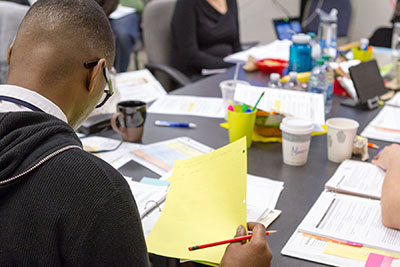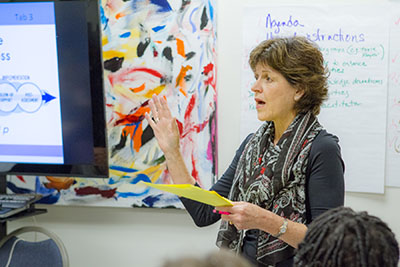Professional Development for Teachers Makes Health Education Soar
By Georgi Roberts and Brooke Sharples | January 29, 2019
Director of Health & Physical Education (GR) and Health Education Coordinator Fort Worth Independent School District (BS)
We are passionate about health education. We believe in educating youth to give them the skills to make good health decisions. If we don’t take these steps, it’s hardly fair for us to expect young people to make the right choices about their health.
In the Fort Worth Independent School District, one of the most powerful ways we support effective health education is through a program of carefully planned, ongoing professional development for teachers. We deliver continuous support, working to strengthen our programs with the goal to engage our students. Thanks to a CDC DASH grant that started six years ago, combined with some fierce determination on the part of our staff, we’ve created a program we’re proud of, and one we believe can be a model for districts around the nation.
This is the second post in a series about health education teachers and professional development. Check out the other posts in this series:
- Exemplary Professional Development: What Are the Critical Elements? outlines the essential components of effective PD.
- Health Teachers + Professional Development Make a True Difference for Students shares the experiences of educators participating in the FWISD professional development program.
Health Education Is Important—And So Is Follow-Through
“Health education is important.” Say it anywhere around your school. Teachers, other staff, school administrators, school board members. Everyone nods their heads and says, “It sure is.” And then they don’t take action to support it.
When we received a CDC DASH grant to provide sexual health education, we worked with our administration and said, “Let’s leverage this money so we can provide true comprehensive school health.” We looked at what we had and what we could do. We showed our administrators the data and we gave them a plan. We figured an estimated cost per student, explained the benefits, and said, "If you approve our 3-5 year plan, we’ll take care of it.”
Virtually every district in the nation is focusing on preparing students to be “College, Career and Military Ready.” This is a perfect pitch for comprehensive health education. The skills taught in an effective program mirror those needed throughout life—the applicability is almost universal. STEM education? Arts? Social sciences? Boys’ academies? Girls’ academies? They all need to be able to comprehend concepts, analyze influences, make decisions, set goals—in short, to effectively address the standards and outcomes of effective health education.
We got our administrative support.
Teaching Health Well Is a Complex Skill
Many people still assume teachers are well-trained in their disciplines—that they’ve been oriented through a strong pedagogy, participated in student teaching and been offered ongoing mentorship. We actually see that less and less these days. In fact, when we did an audit of our health teachers’ transcripts, we discovered that only 4% had any training in health education.
 If we give our health teachers a textbook and computer and say, “Go teach,” it’s not going to work. They need a strong foundation, skills, mentorship and encouragement. We need strategies to help new teachers navigate through the uncertainties and frustrations and a plan to keep veteran teachers on a pathway of constant growth.
If we give our health teachers a textbook and computer and say, “Go teach,” it’s not going to work. They need a strong foundation, skills, mentorship and encouragement. We need strategies to help new teachers navigate through the uncertainties and frustrations and a plan to keep veteran teachers on a pathway of constant growth.
We designed our program to achieve this.
Our Professional Development Program
“Development” is a key concept in professional development (PD) efforts—it’s ongoing, you grow and change in the process, you learn new things. For teachers, we like the analogy of child development—the first two years are incredibly important and can set a tone for continued healthy growth across a professional career.
Here are the components of our program.
New Teacher Academy
Every year, we have new health teachers coming into our district. This year, 18 of our 82 health teachers were new. Two weeks before school begins, these teachers participate in a two-day, nine-hour New Teacher Academy. We cover background information, share our local Youth Risk Behavior Survey (YRBS) data and spark their interest in executing the best lessons for students every day. (Check the CDC’s YRBS website for more information about administering local surveys.)
One of our Master Health Teachers teaches a model lesson from our curriculum (we are using ETR’s HealthSmart program—it beautifully matches our philosophy and goals). The new teachers then break into small groups and review lesson plans. Other experienced teachers in the room offer feedback on preparing the lessons. Each new teacher is then assigned a lesson to prepare as homework.
The next day, they come in and teach their lesson to their group. They work with experienced teachers to give and receive feedback to one another, learning to work constructively not only in how they assess others’ work, but how they manage their own fumbles or insecurities.
All Teacher Training
 A week before school starts, all of our health teachers receive training for one to two days (6-12 hours). These trainings provide updates, skills practice, deeper learning on the principles of health education and issues of current concern. We also invite vetted outside health experts in to address areas of content knowledge.
A week before school starts, all of our health teachers receive training for one to two days (6-12 hours). These trainings provide updates, skills practice, deeper learning on the principles of health education and issues of current concern. We also invite vetted outside health experts in to address areas of content knowledge.
Classroom Teaching and Observation
New teachers begin working directly with students in the classroom. Within their first four weeks, they will be observed in class by a member of the district’s Health Education Department. When possible, this observation is scheduled before a planning period so the teacher and health specialist can meet for immediate discussion and feedback.
Our goal is never to let a teacher go astray due to frustration or confusion. We are there to support them to be the best teacher they can be, no matter what the situation. Sometimes we help them get their computer working or bring more workbooks to their classrooms. Sometimes we talk about ways to make the teaching more student-driven. We might suggest different ways to set up their desks or break students into small groups.
Our hope is that we can offer practical and achievable goals right from the start, and build in a successful, positive attitude about the process of continuous improvement.
 In October, after some experience teaching and an observation session, we pull all first and second year teachers out of their class and have them observe one of our highly skilled veteran teachers in a class. We do this in groups of two or three teachers at a time, and again schedule this with a planning period immediately after for discussion and feedback.
In October, after some experience teaching and an observation session, we pull all first and second year teachers out of their class and have them observe one of our highly skilled veteran teachers in a class. We do this in groups of two or three teachers at a time, and again schedule this with a planning period immediately after for discussion and feedback.
Now that we are a few years into this program, we have built a solid group of teachers who are consistently doing a good job in their classrooms. We know we can count on them to act as mentors and peer leaders with our newer teachers. They know that we are excited to see them continue to grow professionally in their own work.
Characteristics of Effective Health Education
Once teachers have some hands-on experience in the classroom, along with opportunities to both observe and be observed, we provide a six-hour training on the Characteristics of Effective Health Education. This training does an amazing job of deepening teachers’ understanding of the practices and principles that make health education work.
We find that when teachers are able to grasp these principles, they bring more effective and creative thinking to the individual needs of each class and each student. It moves them well beyond a cookie-cutter approach, and into the territory of highly effective teaching.
What Does Success Look Like?
We are monitoring our local YRBS findings to see how they might change as we go forward. We did not anticipate any movement in the first and second administration of the survey, which occurred early in our program. The 2019 YRBS data will be the third administration for us and we are looking forward to seeing what it tells us. The data is powerful; it informs both the teaching and the public’s understanding of the choices our children are making.
We do know that our students show improvement in the knowledge-based pre- and post-test measurements. The academic year 2018-19 will be the first time we survey ninth graders who participated in the sixth grade middle-school program, and we are eager to see what kinds of knowledge and skills they bring forward from that experience.
We are also finding other ways to look at the performance of our program.
 We feel its success every time we walk into a classroom and see it working. We hear students talk about the new ways they’re thinking about their health choices and behaviors. We see small group reports where students take the facts and make them relevant to their lives—they’re not just regurgitating information, they’re comprehending concepts and analyzing influences and making decisions and setting goals. We see teachers working with enthusiasm and inspiration to engage their students. They reach out to us to tell us stories and share articles. Teachers see themselves as essential elements of this professional effort to enhance students’ lives.
We feel its success every time we walk into a classroom and see it working. We hear students talk about the new ways they’re thinking about their health choices and behaviors. We see small group reports where students take the facts and make them relevant to their lives—they’re not just regurgitating information, they’re comprehending concepts and analyzing influences and making decisions and setting goals. We see teachers working with enthusiasm and inspiration to engage their students. They reach out to us to tell us stories and share articles. Teachers see themselves as essential elements of this professional effort to enhance students’ lives.
In fact, one teacher who always loved teaching health and has been a very successful coach told us recently that she wished she didn’t have to coach any more. She’d rather just teach health education. That’s quite a change from the old story of a coach who’s assigned a couple of health classes and teaches them reluctantly.
Success Story: A Cousin with HIV
A teacher was covering the unit on HIV—what it is, how people get it, how they don’t. A student raised his hand.
“My cousin has HIV and I’m not supposed to visit him because I might get HIV. Do you mean that it’s okay for me to go see him?” The teacher assured him that the visit would be safe, and arranged for the student to meet with the school nurse to corroborate these facts. The student was excited to know that it would be okay to see his cousin again.
Success Story: Emotional and Mental Health
A sixth-grade teacher was covering the unit on Emotional and Mental Health, including a segment on how to find trusted adults for support. The class was discussing grief and loss.
One student shared that his two cousins had died the night before in a car crash. The teacher listened attentively and compassionately, affirmed the student’s feelings and expressed his condolences. All of the other students in the class watched this exchange carefully.
Then the bell rang.
As students began to gather up their things and move away from their desks, three of the students went over to talk to the grieving student and give him hugs.
The teacher was so moved by this entire experience that he shared it with us soon after the class. “This unit, and the students’ responses to it, are helping me with my own emotions,” he told us.
Turning the Ship: Proud of Health Education
Yes, we are passionate and enthusiastic about health education. We want more people to see its value. What better way to turn that ship than to build a cadre of teachers who are proud of their work, who speak up in their communities, who let their voices be heard at the ballot box, who advocate for students both as parents and professionals?
We believe this is a model that can be used throughout public education on any subject. We can track teachers carefully in their early years of teaching, providing solid professional development and mentorship. By investing more up front, we are better able to decrease turnover and use the power of teacher pride to improve the ways we reach students in every single class.
Georgi Roberts is Director of the Health & Physical Education Department in the Fort Worth Independent School District. She can be reached at georgi.roberts@fwisd.org. Brooke Sharples is a Health Education Coordinator. She can be reached at Brooke.Sharples@fwisd.org.





